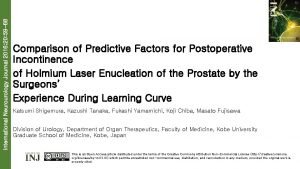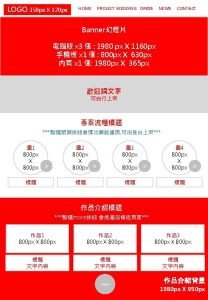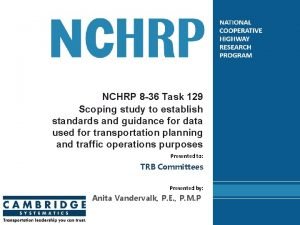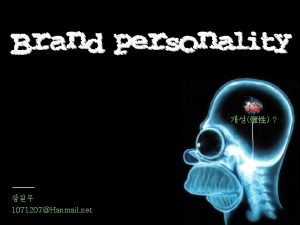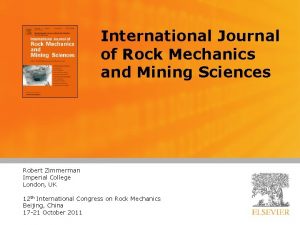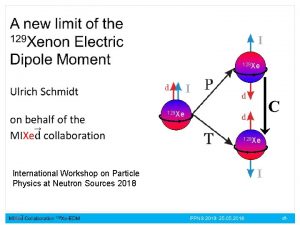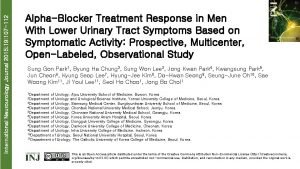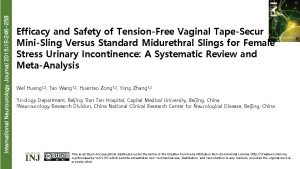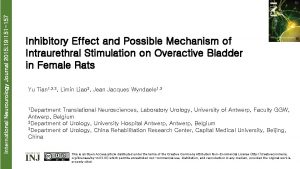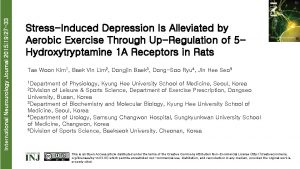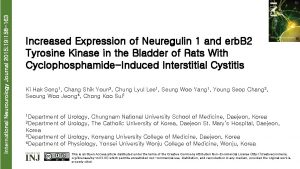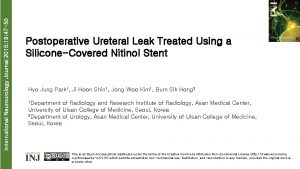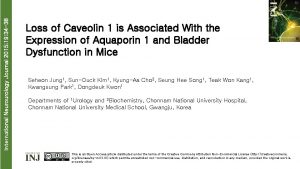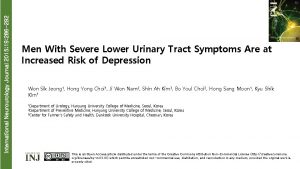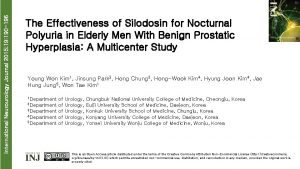International Neurourology Journal 2015 19 120 129 The












- Slides: 12

International Neurourology Journal 2015; 19: 120 -129 The Impact of Lower Urinary Tract Symptoms on Quality of Life, Work Productivity, Depressive Symptoms, and Sexuality in Korean Men Aged 40 Years and Older: A Population. Based Survey Tae Heon Kim 1, *, Deok Hyun Han 1, *, Dong-Soo Ryu 2, Kyu-Sung Lee 1, 3 1 Department of Urology, Samsung Medical Center, Sungkyunkwan University School of Medicine, Seoul, Korea 2 Department of Urology, Samsung Changwon Hospital, Sungkyunkwan University School of Medicine, Changwon, Korea 3 Department of Medical Device Management & Research, SAIHST, Sungkyunkwan University, Seoul, Korea This is an Open Access article distributed under the terms of the Creative Commons Attribution Non-Commercial License (http: //creativecommons. org/licenses/by-nc/3. 0/) which permits unrestricted non-commercial use, distribution, and reproduction in any medium, provided the original work is properly cited.

International Neurourology Journal 2015; 19: 120 -129 PURPOSE • The impact of lower urinary tract symptoms (LUTS) on health-related quality of life (HRQo. L) in Korean men aged ≥ 40 years was examine.

International Neurourology Journal 2015; 19: 120 -129 MATERIALS AND MRTHODS • A population-based, cross-sectional door-to-door survey was conducted among men aged ≥ 40 years. • Structured questionnaires were used to assess several dimensions of HRQo. L, including generic health status (Euro. Qo. L-five-dimensions questionnaire), work productivity (work productivity and activity impairment questionnaire), depressive symptoms (center for epidemiologic studies depression scale), and sexual health (sexual satisfaction and erectile dysfunction). • The impact of LUTS was assessed by comparing several dimensions of HRQo. L among men with and without LUTS.

International Neurourology Journal 2015; 19: 120 -129 RESULTS • Of the 1, 842 participants, 1, 536 (83. 4%) reported having at least one LUTS. • The prevalence of LUTS increased with age (78. 3% among those aged 40– 49 years to 89. 6% among those aged 60 years or older). • Those with LUTS reported a significantly lower level of generic health status and worse work productivity compared with those without LUTS. • Significantly more individuals with LUTS reported having a higher level of major depressive symptoms compared with those without LUTS. • Those with LUTS reported worse sexual activity and enjoyment, and were significantly more likely to have erectile dysfunction than those without LUTS.

International Neurourology Journal 2015; 19: 120 -129 CONCLUSIONS • LUTS seem to have a substantial impact on several dimensions of HRQo. L in Korean men aged ≥ 40 years.

International Neurourology Journal 2015; 19: 120 -129 Fig. 1. The percentage of respondents with lower urinary tract symptoms (LUTS) by age groups.

International Neurourology Journal 2015; 19: 120 -129 Fig. 2. The percentage of the respondents with problems in the quality of life domains of the EQ-5 D questionnaire by dimension. LUTS, lower urinary tract symptoms; EQ-5 D, Euro. Qo. L-five dimensions. *P<0. 001.

International Neurourology Journal 2015; 19: 120 -129 Table 1. Demographic data and medical comorbidities of the participants Characteristic Total participants (n=1, 842) Individuals with LUTS (n=1, 536) Individuals without LUTS (n=306) Age group (yr) <0. 001 40– 49 751 (40. 8) 588 (38. 3) 163 (53. 3) 50– 59 609 (33. 1) 516 (33. 6) 93 (30. 4) ≥ 60 482 (26. 2) 432 (28. 1) 50 (16. 3) Educational level High school graduate or less College or more 0. 973 408 (22. 1) 340 (22. 1) 68 (22. 2) 1, 434 (77. 9) 1, 196 (77. 9) 238 (77. 8) Marital status Married or live with partner P-valuea) 0. 602 1, 670 (90. 7) 1, 395 (90. 8) 275 (89. 9) 172 (9. 3) 141 (9. 2) 31 (10. 1) Asthma 88 (4. 8) 84 (5. 5) 4 (1. 3) 0. 002 Chronic cough 146 (7. 9) 136 (8. 9) 10 (3. 3) 0. 001 Diabetes 221 (12. 0) 203 (13. 2) 18 (5. 9) < 0. 001 High blood pressure 542 (29. 4) 475 (30. 9) 67 (21. 9) 0. 002 Neurologic disease 27 (1. 5) 24 (1. 6) 3 (1. 0) 0. 605 Depression 119 (6. 5) 112 (7. 3) 7 (2. 3) 0. 001 Chronic constipation 114 (6. 2) 104 (6. 8) 10 (3. 3) 0. 020 Single or live without partner Comorbidities Values are presented as number (%). LUTS, lower urinary tract symptoms. a)Comparisons among individuals with LUTS and without LUTS.

International Neurourology Journal 2015; 19: 120 -129 Table 2. Participant-reported outcomes by all age (aged ≥ 40 years) Variable Individuals with LUTS Individuals without LUTS EQ-5 D index score (n=1, 842) 0. 89± 0. 16 0. 95± 0. 10 P-value <0. 001 EQ-VAS score (n=1, 842) 74. 9± 18. 8 78. 0± 21. 9 <0. 001 Full time 924 (60. 2) 224 (73. 2) <0. 001 Part time 196 (12. 8) 29 (9. 5) Not employed 416 (27. 1) 53 (17. 3) 1. 4± 5. 3 0. 6± 4. 2 0. 004 Impairment while working due to health (n=1, 231) 14. 5± 26. 6 9. 3± 23. 7 <0. 001 Overall work impairment due to health (n=972) 14. 1± 26. 0 8. 3± 22. 5 <0. 001 Activity impairment due to health (n=1, 667) 15. 9± 25. 4 9. 5± 22. 7 <0. 001 Any work impairment (n=1, 036) 326 (39. 2) 50 (24. 5) <0. 001 CES-D scale ≥ 21 (n=1, 842) 177 (11. 5) 9 (2. 9) <0. 001 Currently sexually active (n=1, 835) 837 (54. 6) 206 (68. 0) <0. 001 264 (17. 2) 15 (5. 0) <0. 001 89 (10. 6) 7 (3. 4) <0. 001 724 (86. 5) 190 (92. 2) 0. 025 75 (9. 0) 2 (1. 0) <0. 001 Employment status (n=1, 842) WPAI (%) Work time missed due to health (n=995) Decreased sexual activity (n=1, 835) ‘Quite a bit’ to ‘a great deal’ Decreased enjoyment of sexual activity (n=1, 043) ‘Quite a bit’ to ‘a great deal’ Satisfaction for sexual activity (n=1, 043) ED (n=1, 043) ‘Moderately impotent’ to completely impotent’ Values are presented as mean±standard deviation or number (%). LUTS, lower urinary tract symptoms; EQ-5 D, Euro. Qo. L-five dimensions; EQ-VAS, Euro. Qo. Lvisual analogue scale; WPAI, work productivity and active impairment; CES-D, center for epidemiological studies depression scale; ED, erectile dysfunction.

International Neurourology Journal 2015; 19: 120 -129 Table 3. Participant-reported outcomes by age 40 -49 years Variable Individuals with LUTS Individuals without LUTS EQ-5 D index score (n=751) 0. 90± 0. 15 0. 95± 0. 09 P-value <0. 001 EQ-VAS score (n=751) 73. 7± 18. 8 77. 5± 19. 4 0. 001 Full time 454 (77. 2) 129 (79. 1) 0. 156 Part time 66 (11. 2) 9 (5. 5) Not employed 68 (11. 6) 25 (15. 3) 1. 8± 6. 6 0. 4± 3. 2 0. 033 Impairment while working due to health (n=579) 17. 4± 29. 0 11. 5± 25. 3 0. 068 Overall work impairment due to health (n=460) 17. 3± 28. 4 10. 8± 24. 7 0. 034 Activity impairment due to health (n=667) 15. 2± 25. 0 10. 8± 23. 3 0. 005 Any work impairment (n=497) 176 (45. 4) 32 (29. 4) 0. 009 CES-D scale ≥ 21 (n=751) 99 (16. 8) 6 (3. 7) <0. 001 Currently sexually active (n=751) 346 (58. 8) 111 (68. 1) 0. 111 95 (16. 2) 12 (7. 4) 0. 010 39 (11. 3) 5 (4. 5) 0. 122 296 (85. 6) 102 (91. 9) 0. 309 18 (5. 2) 1 (0. 9) 0. 164 Employment status (n=751) WPAI (%) Work time missed due to health (n=474) Decreased sexual activity (n=751) ‘Quite a bit’ to ‘a great deal’ Decreased enjoyment of sexual activity (n=457) ‘Quite a bit’ to ‘a great deal’ Satisfaction for sexual activity (n=457) ED (n=457) ‘Moderately impotent’ to completely impotent’ Values are presented as mean±standard deviation or number (%). LUTS, lower urinary tract symptoms; EQ-5 D, Euro. Qo. L-five dimensions; EQ-VAS, Euro. Qo. Lvisual analogue scale; WPAI, work productivity and active impairment; CES-D, center for epidemiological studies depression scale; ED, erectile dysfunction.

International Neurourology Journal 2015; 19: 120 -129 Table 4. Participant-reported outcomes by age 50 -59 years Variable EQ-5 D index score (n=609) Individuals with LUTS 0. 89± 0. 15 Individuals without LUTS 0. 96± 0. 09 P-value <0. 001 75. 6± 18. 5 78. 6± 26. 1 <0. 001 Full time 358 (69. 4) 74 (79. 6) 0. 243 Part time 54 (10. 5) 9 (9. 7) Not employed 104 (20. 2) 10 (10. 8) 1. 1± 4. 1 0. 9± 6. 0 1. 000 Impairment while working due to health (n=457) 11. 8± 23. 3 5. 1± 18. 4 0. 009 Overall work impairment due to health (n=368) 11. 1± 22. 3 5. 6± 19. 6 0. 033 Activity impairment due to health (n=561) 14. 8± 24. 9 5. 6± 20. 0 <0. 001 111 (35. 1) 14 (19. 7) 0. 035 42 (8. 1) 3 (3. 2) 0. 388 307 (59. 8) 65 (71. 4) 0. 139 75 (14. 6) 2 (2. 2) <0. 001 29 (9. 5) 2 (3. 1) 0. 405 270 (88. 0) 59 (90. 8) 1. 000 24 (7. 8) 0 (0) 0. 036 EQ-VAS score (n=609) Employment status (n=609) WPAI (%) Work time missed due to health (n=374) Any work impairment (n=387) CES-D scale ≥ 21 (n=609) Currently sexually active (n=604) Decreased sexual activity (n=604) ‘Quite a bit’ to ‘a great deal’ Decreased enjoyment of sexual activity (n=372) ‘Quite a bit’ to ‘a great deal’ Satisfaction for sexual activity (n=372) ED (n=372) ‘Moderately impotent’ to completely impotent’ Values are presented as mean±standard deviation or number (%). LUTS, lower urinary tract symptoms; EQ-5 D, Euro. Qo. L-five dimensions; EQ-VAS, Euro. Qo. Lvisual analogue scale; WPAI, work productivity and active impairment; CES-D, center for epidemiological studies depression scale; ED, erectile dysfunction.

International Neurourology Journal 2015; 19: 120 -129 Table 5. Participant-reported outcomes by age 60 years or older Variable Individuals with LUTS Individuals without LUTS EQ-5 D index score (n=482) 0. 88± 0. 17 0. 94± 0. 13 P-value 0. 028 EQ-VAS score (n=482) 75. 7± 19. 2 78. 7± 21. 2 0. 142 Full time 112 (25. 9) 21 (42. 0) 0. 048 Part time 76 (17. 6) 11 (22. 0) Not employed 244 (56. 5) 18 (36. 0) 1. 0± 3. 3 0. 2± 0. 7 1. 000 Impairment while working due to health (n=195) 12. 7± 26. 3 11. 1± 28. 3 1. 000 Overall work impairment due to health (n=144) 12. 5± 26. 0 5. 5± 18. 7 1. 000 Activity impairment due to health (n=439) 18. 0± 26. 3 14. 4± 24. 9 0. 195 Any work impairment (n=152) 39 (30. 5) 4 (16. 7) 0. 660 CES-D scale ≥ 21 (n=482) 36 (8. 3) 0 (0) 0. 120 184 (42. 7) 30 (61. 2) 0. 046 94 (21. 8) 1 (2. 0) <0. 001 21 (11. 4) 0 (0) 0. 151 158 (85. 9) 29 (96. 7) 0. 413 33 (17. 9) 1 (3. 3) 0. 167 Employment status (n=482) WPAI (%) Work time missed due to health (n=147) Currently sexually active (n=480) Decreased sexual activity (n=480) ‘Quite a bit’ to ‘a great deal’ Decreased enjoyment ofsexual activity (n=214) ‘Quite a bit’’ to ‘a great deal’ Satisfaction for sexual activity (n=214) ED (n=1, 043) ‘Moderately impotent’ to ‘completely impotent’ Values are presented as mean±standard deviation or number (%). LUTS, lower urinary tract symptoms; EQ-5 D, Euro. Qo. L-five dimensions; EQ-VAS, Euro. Qo. Lvisual analogue scale; WPAI, work productivity and active impairment; CES-D, center for epidemiological studies depression scale; ED, erectile dysfunction.
